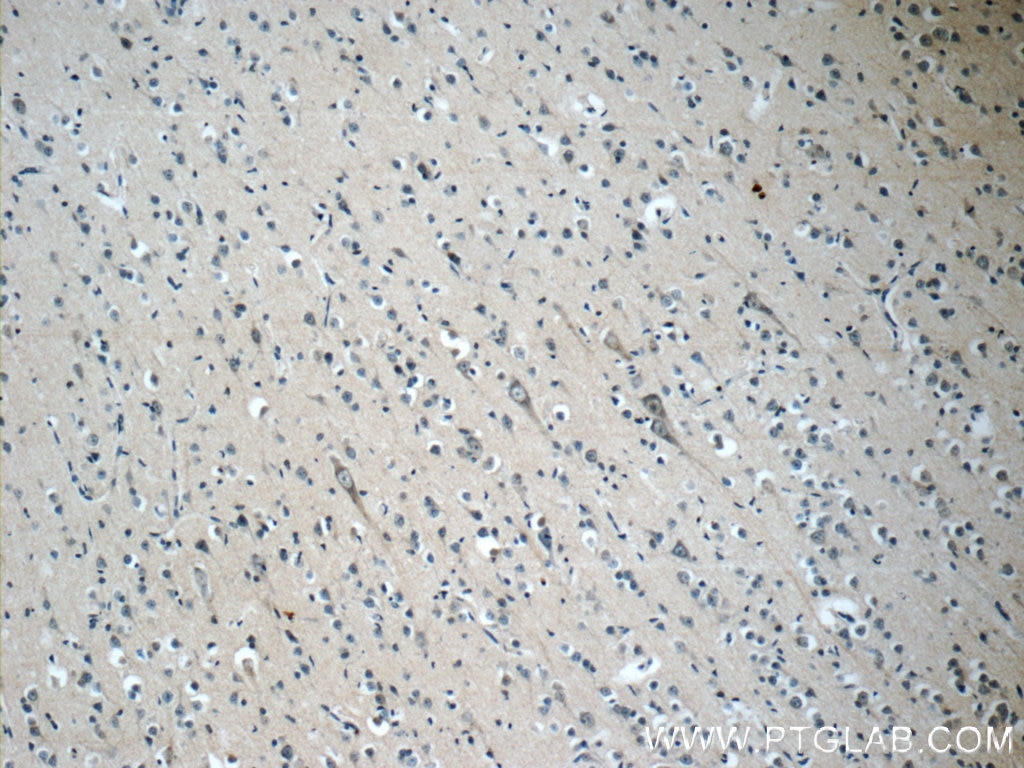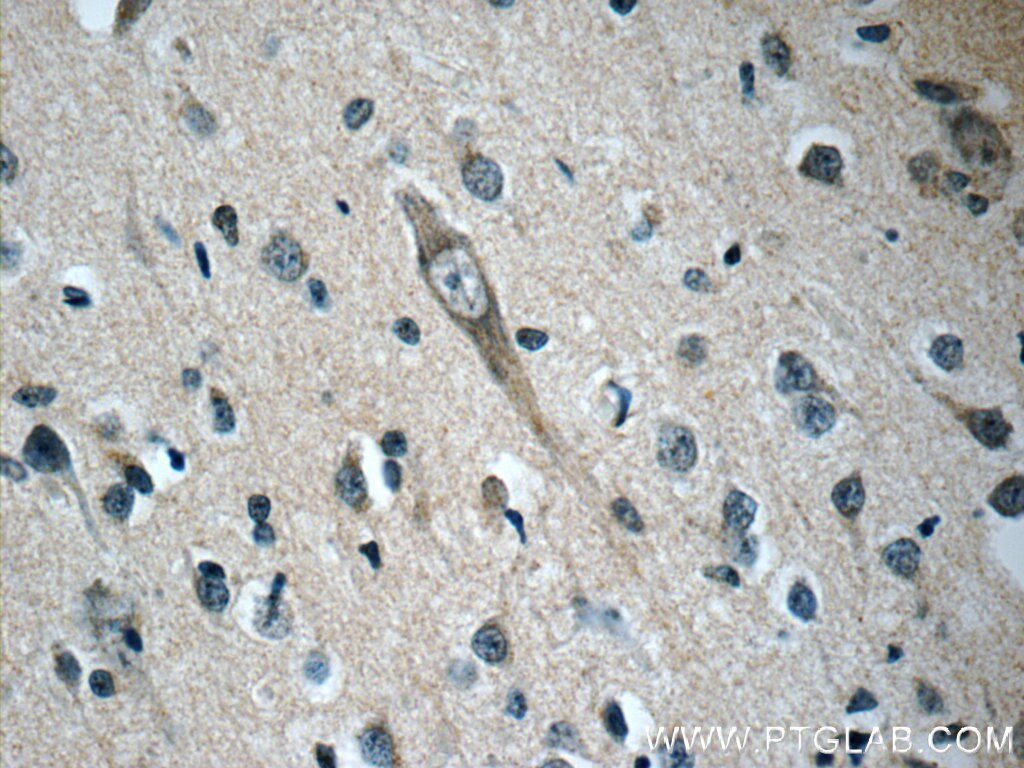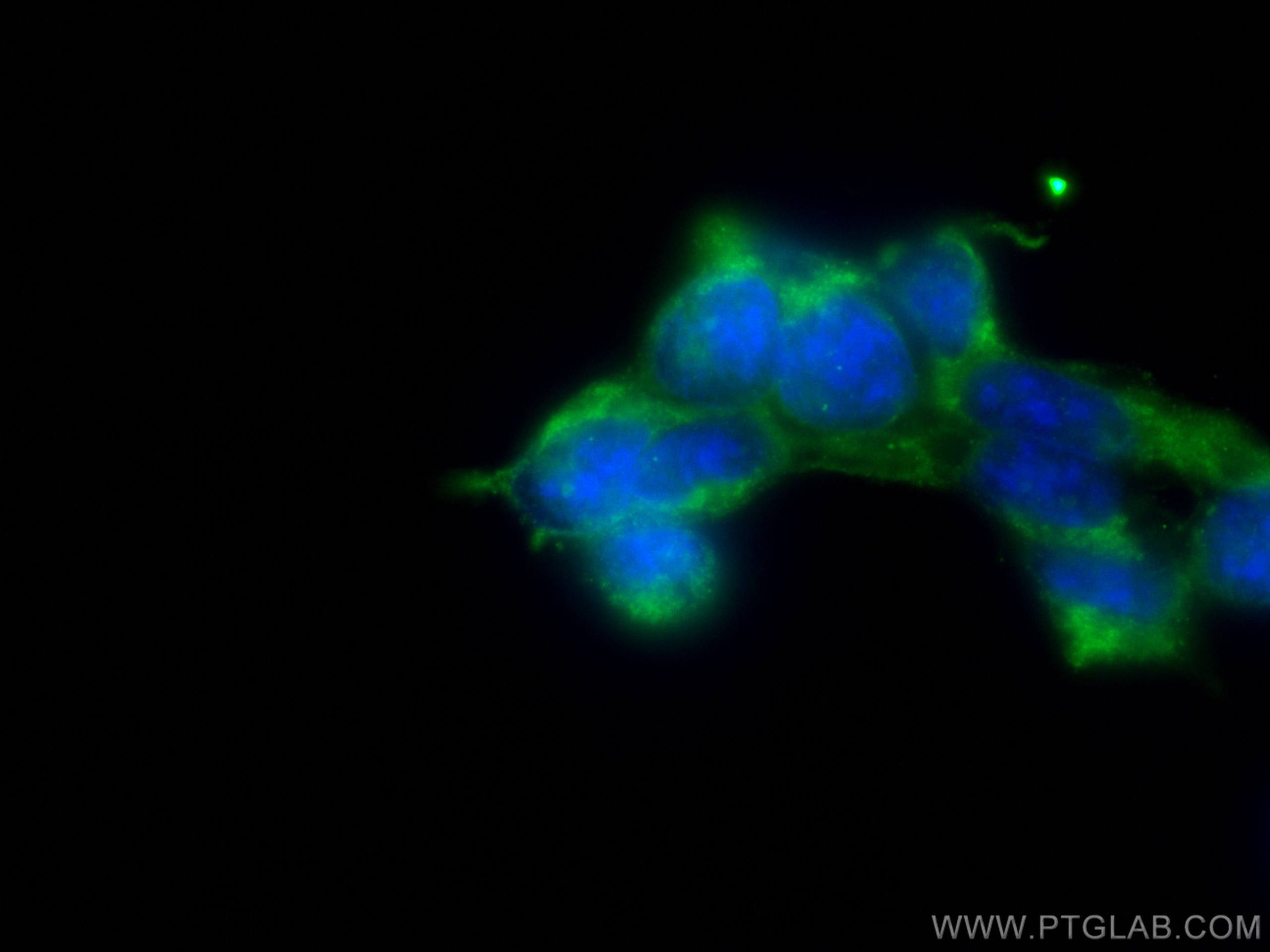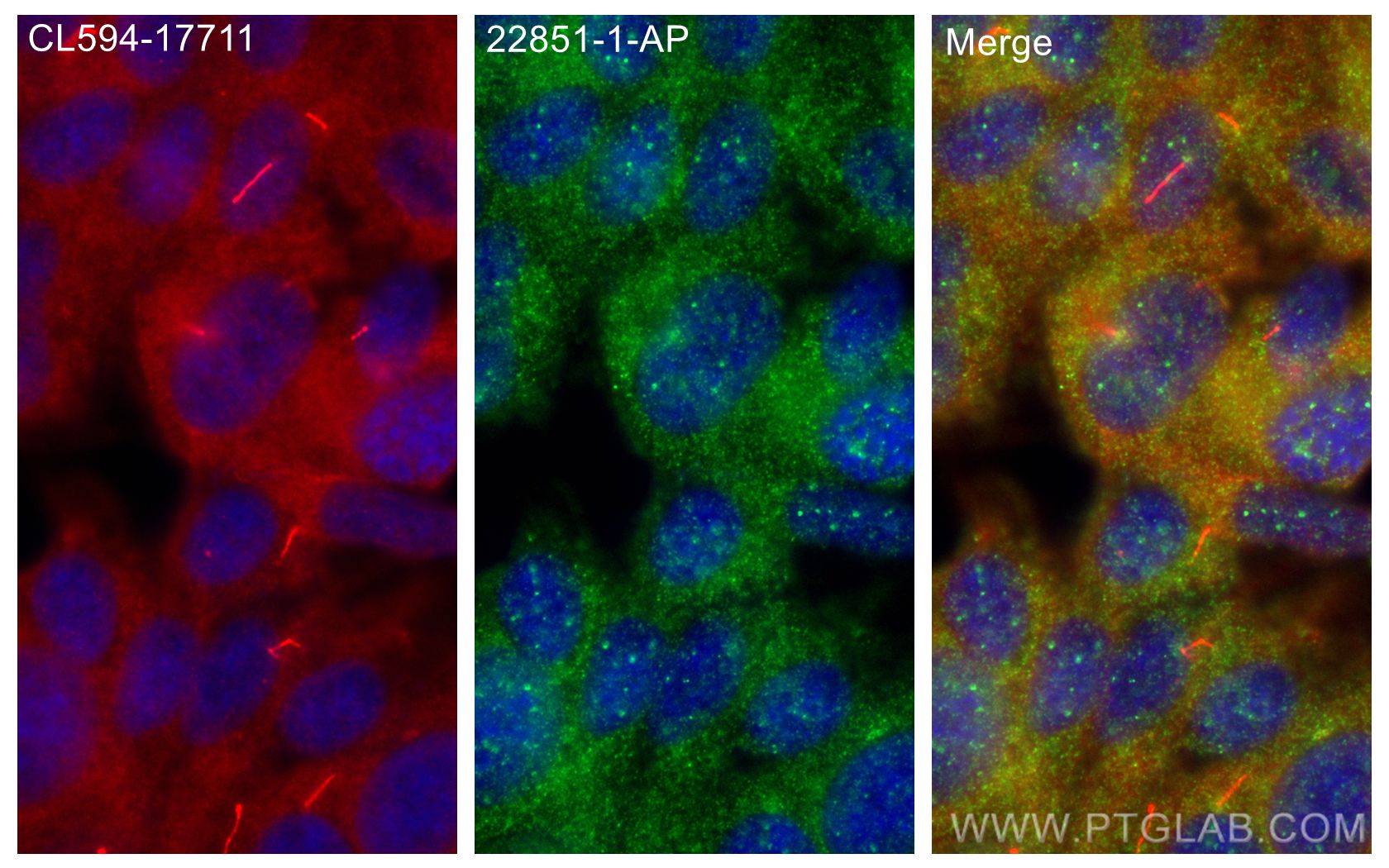Tested Applications
| Positive IHC detected in | human brain tissue Note: suggested antigen retrieval with TE buffer pH 9.0; (*) Alternatively, antigen retrieval may be performed with citrate buffer pH 6.0 |
| Positive IF/ICC detected in | HEK-293 cells, hTERT-RPE1 cells |
Recommended dilution
| Application | Dilution |
|---|---|
| Immunohistochemistry (IHC) | IHC : 1:20-1:200 |
| Immunofluorescence (IF)/ICC | IF/ICC : 1:50-1:500 |
| It is recommended that this reagent should be titrated in each testing system to obtain optimal results. | |
| Sample-dependent, Check data in validation data gallery. | |
Published Applications
| WB | See 4 publications below |
| IF | See 4 publications below |
Product Information
22851-1-AP targets OFD1 in WB, IHC, IF/ICC, ELISA applications and shows reactivity with human samples.
| Tested Reactivity | human |
| Cited Reactivity | human, mouse, rat, zebrafish |
| Host / Isotype | Rabbit / IgG |
| Class | Polyclonal |
| Type | Antibody |
| Immunogen |
CatNo: Ag18898 Product name: Recombinant human OFD1 protein Source: e coli.-derived, PGEX-4T Tag: GST Domain: 1-305 aa of BC096344 Sequence: MMAQSNMFTVADVLSQDELRKKLYQTFKDRGILDTLKTQLRNQLIHELMHPVLSGELQPRSISVEGSSLLIGASNSLVADHLQRCGYEYSLSVFFPESGLAKEKVFTMQDLLQLIKINPTSSLYKSLVSGSDKENQKGFLMHFLKELAEYHQAKESCNMETQTSSTFNRDSLAEKLQLIDDQFADAYPQRIKFESLEIKLNEYKREIEEQLRAEMCQKLKFFKDTEIAKIKMEAKKKYEKELTMFQNDFEKACQAKSEALVLREKSTLERIHKHQEIETKEIYAQRQLLLKDMDLLRGREAELKQ Predict reactive species |
| Full Name | oral-facial-digital syndrome 1 |
| Calculated Molecular Weight | 1012 aa, 117 kDa |
| Observed Molecular Weight | 110-120 kDa |
| GenBank Accession Number | BC096344 |
| Gene Symbol | OFD1 |
| Gene ID (NCBI) | 8481 |
| RRID | AB_2879177 |
| Conjugate | Unconjugated |
| Form | Liquid |
| Purification Method | Antigen affinity purification |
| UNIPROT ID | O75665 |
| Storage Buffer | PBS with 0.02% sodium azide and 50% glycerol, pH 7.3. |
| Storage Conditions | Store at -20°C. Stable for one year after shipment. Aliquoting is unnecessary for -20oC storage. 20ul sizes contain 0.1% BSA. |
Background Information
OFD1, also named CXorf5 and 71-7A, belongs to the OFD1 family. It has been implicated in several developmental syndromes, including a male-lethal X-linked dominant condition, Oral-Facial-Digital type 1 (OFD1) syndrome, X-linked recessiveSimpson-Golabi-Behmel syndrome type 2 (SGBS2), and Joubert syndrome and related disorders (JSRDs). It is a component of the centrioles controlling mother and daughter centrioles' length. It recruits to the centriole IFT88 and centriole distal appendage-specific proteins including CEP164. Involved in the biogenesis of the cilium, a centriole-associated function. OFD1 plays an important role in development by regulating Wnt signaling and the specification of the left-right axis. This antibody recognizes all the isoforms of OFD1. The 43 kDa is isoform 2. The ~80 kDa band is unknown.
Protocols
| Product Specific Protocols | |
|---|---|
| IF protocol for OFD1 antibody 22851-1-AP | Download protocol |
| IHC protocol for OFD1 antibody 22851-1-AP | Download protocol |
| Standard Protocols | |
|---|---|
| Click here to view our Standard Protocols |
Publications
| Species | Application | Title |
|---|---|---|
Nat Commun Coupling bimolecular PARylation biosensors with genetic screens to identify PARylation targets. | ||
PLoS Biol Acute inhibition of centriolar satellite function and positioning reveals their functions at the primary cilium. | ||
Biochem Biophys Res Commun BIX-01294-induced autophagy regulates elongation of primary cilia. | ||
Oncol Lett Abnormal accumulation of OFD1 in endometrial cancer with poor prognosis inhibits ciliogenesis. | ||
Cell Biosci IK is essentially involved in ciliogenesis as an upstream regulator of oral-facial-digital syndrome ciliopathy gene, ofd1 |
Reviews
The reviews below have been submitted by verified Proteintech customers who received an incentive for providing their feedback.
FH Elisa (Verified Customer) (06-15-2022) | HEK293 cells stained for Hoechst (DNA marker, in green), OFD1 (mother centriole distal appendage marker, in magenta) and PCNT (pericentriolar matrix marker, in green). HEK293 cells were plated on Poly-lysine coated coverslips and fixed in cold methanol for 2' at -20C. Cells were then rehydrated with PBS for 5'. Membrane permeabilization was then performed with 0.1% Triton + 0.1% Tween +0.01%SDS in PBS for 5'. Cells were finally incubated with blocking buffer (5% BSA+ 0.1% Tween in PBS) for 30' at RT. Primary antibody was diluted in blocking buffer 1:200 and incubated for 1h at room temperature. Alexa-555-Anti-rabbit was used as secondary antibody (1:600 dilution) (1h at room temperature). OFD1 recognises mother centriole.
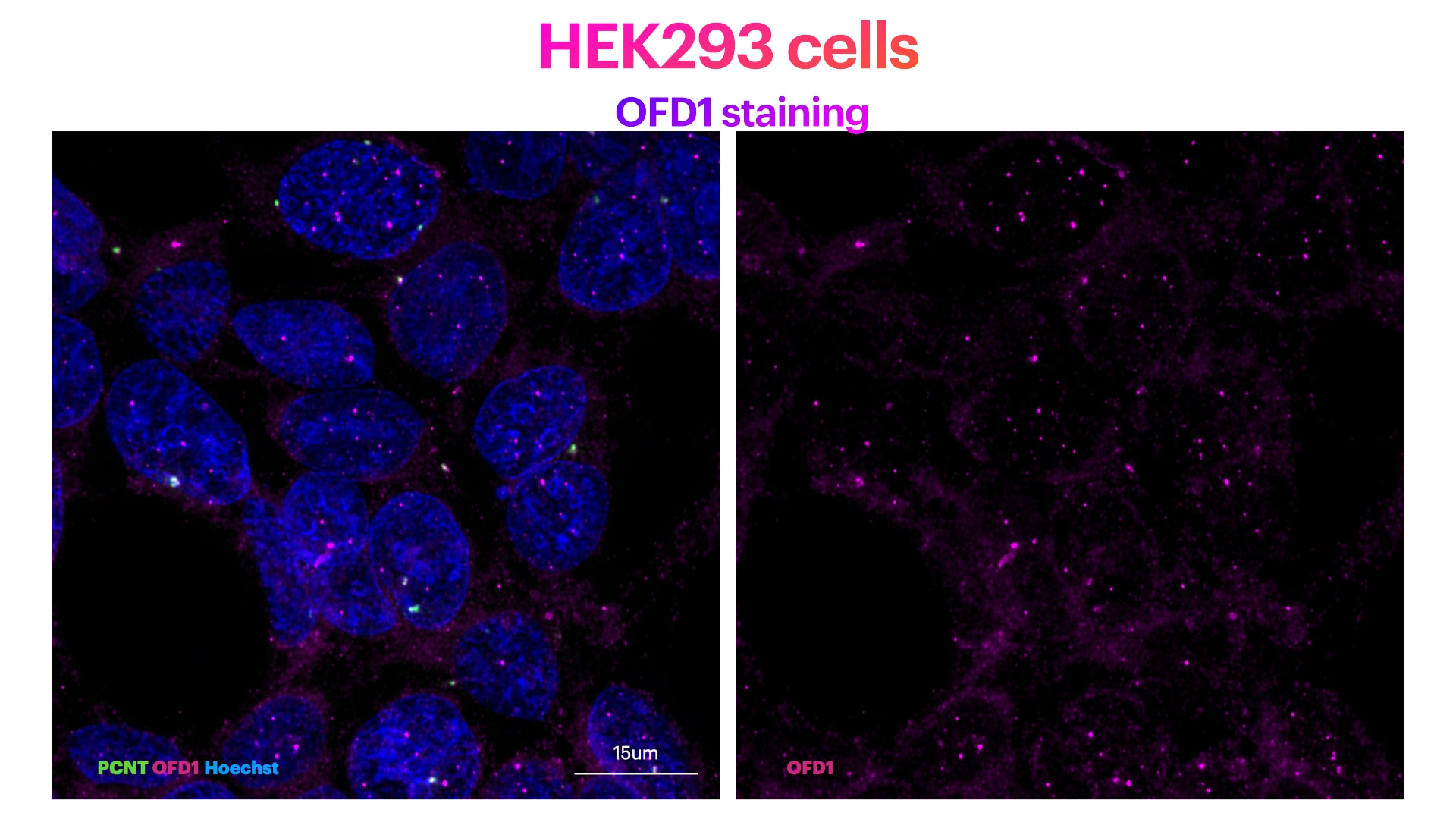 |
FH Sarah (Verified Customer) (02-16-2021) | Works very well for detection of OFD1 in HEK 293T cells
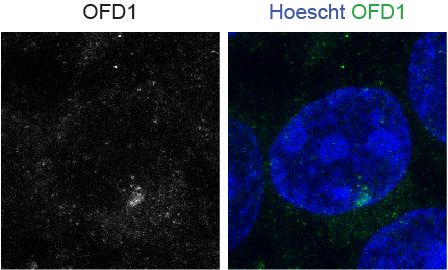 |

